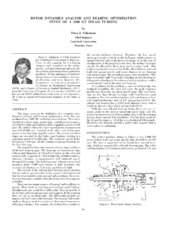| dc.description.abstract | This paper presents the highlights of a complete rotor dynamics analysis and bearing optimization study that was performed on a 3800 HP multistage steam turbine. This unit is coupled to a three stage, poster-type, centrifugal air compressor with two high speed pinion shafts engaging a common bull gear. The turbine drives the lower speed pinion at a maximum speed of 10,500 rpm. Located at the other end of this same pinion is the first stage impeller wheel. The second and third stages are mounted on the higher speed pinion, rotating at a maximum speed of 13,600 rpm. The maximum speed of the bull gear is 1, 940 rpm. All the existing compressor bearings are the four-lobe type. The original turbine rotor consists of three stages and has a 41.34 inch bearing span. The bearings are lemon-bore type with journal diameters of 3.0 and 4.0 inches on the inlet and exhaust ends, respectively. This turbine has exhibited subsynchronous vibration, at approximately half rotational speed, during field testing. The half frequency vibration prevented operation above 9,400 rpm because a shaft resonance was excited and vibration levels became prohibitively high. The analysis of the existing rotor-bearing system predicts that the turbine operates close to the second critical speed and that the rotor is stable under normal load conditions. However, the rotor becomes unstable when the lemon-bore bearings are unloaded. There are two major sources of bearing load in addition to gravity. These loads are misalignment and gear mesh loading. Misalignment can result from differential thermal growth of the turbine and compressor cases and supports. If the coupling does not act as an ideal joint, this differential growth can impose external loads at the bearings. The bearing load resulting from the gear mesh is a reaction to the torque transmission at the gear interface. For example, the turbine driver rotates in the counter-clockwise direction. Therefore, the low speed pinion gear tends to climb up the bull gear, which causes an upward external load on the pinion bearings. As in the case of misalignment, if the coupling is not ideal, the turbine bearings can also be affected by these gear mesh reaction loads. This analysis is primarily concerned with the effect of these external loads that oppose gravity and cause degrees of net bearing unloading because the unloading causes rotor instability. The rotor is unstable with 75 pounds unloading at each bearing or 110 pounds unloading at the exhaust end bearing alone (with a normal gravity load at the inlet end bearing). As a solution to the problem, a new set of bearings was designed to stabilize the rotor and move the peak response speeds away from the operating speed range. The new bearings are five-shoe-tilt-pad bearings with load-between-pad orientation. The inlet end bearing has a 3.0 inch diameter bore with length-to-diameter ratio of 1.0; and preload of 0.8. The exhaust end bearing has a 3. 995 inch diameter bore with a length-to-diameter ratio of 0.4 and preload of 0.0. With the new tilt-pad bearing design there are no response peaks in the normal operating speed range and the system log decrement is 2.8 times higher than with the existing system, under normal load conditions. The log decrement for the tilt-pad bearings is +0.52 for an unloading of 100 pounds. Therefore, the tilt-pads provide a stable rotor support that is not sensitive to unloading. | en |


